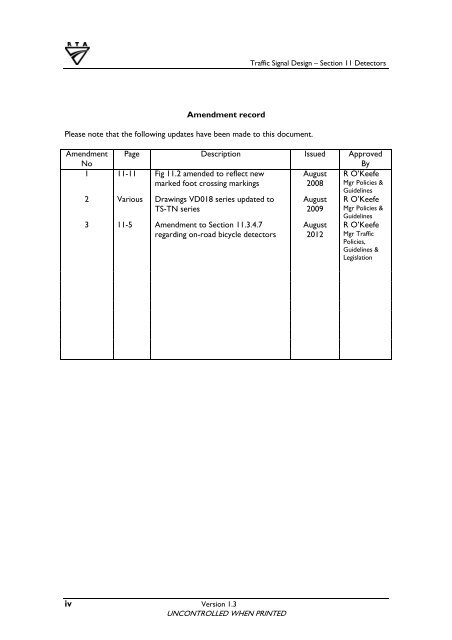Traffic Signal Design - Section 11 Detectors - RTA
Traffic Signal Design - Section 11 Detectors - RTA Traffic Signal Design - Section 11 Detectors - RTA
Traffic Signal Design – Section 11 Detectors Amendment record Please note that the following updates have been made to this document. Amendment No Page Description Issued Approved By 1 11-11 Fig 11.2 amended to reflect new August R O’Keefe marked foot crossing markings 2008 Mgr Policies & Guidelines 2 Various Drawings VD018 series updated to TS-TN series August 2009 R O’Keefe Mgr Policies & 3 11-5 Amendment to Section 11.3.4.7 regarding on-road bicycle detectors August 2012 Guidelines R O’Keefe Mgr Traffic Policies, Guidelines & Legislation iv Version 1.3 UNCONTROLLED WHEN PRINTED
Traffic Signal Design – Section 11 Detectors 11.1 INTRODUCTION Detectors are used to register the presence and/or passage of vehicles and pedestrians. Demands are generated by the detection of vehicles, operation of pedestrian push buttons and other sensors, switches and devices. These demands allow the controller to determine the signal displays required, their initiation and duration. This section discusses the various types of vehicle and pedestrian detectors and their location, labelling and numbering. There are also brief comments on detector operation and detector logic, but full details of these topics may be found in Traffic Signal Operation and drawing No. TS-TN-020 respectively. 11.2 TYPES AND USES OF DETECTORS Figure 11.1 shows the types of detectors currently in use: • vehicle detectors • push button detectors • special detectors The use of these detectors is determined by the type of traffic to be detected. This includes: • vehicles • pedestrians • priority traffic (e.g. emergency services vehicles and trains) • specific vehicles (e.g. buses, bicycles and wheelchairs) Figure 11.1 Types of detectors Vehicle detectors are the most common. Many physical principles (such as radar, light and sound) have been used in vehicle detectors. The two types currently in use are the inductive loop detector and the microwave (radar) detector. The microwave detector cannot detect stationary vehicles and is only used as a temporary measure when loop detectors fail and is not further described here. Push-button detectors are usually provided for the use of pedestrians, however, in some instances they are also provided for either on-road or off-road bicycle riders. Version 1.3 11-1 UNCONTROLLED WHEN PRINTED
- Page 1 and 2: Traffic signal design Section 11 -
- Page 3 and 4: Traffic Signal Design Section 11 DE
- Page 5: Traffic Signal Design - Section 11
- Page 9 and 10: Traffic Signal Design - Section 11
- Page 11 and 12: Traffic Signal Design - Section 11
- Page 13 and 14: Traffic Signal Design - Section 11
- Page 15 and 16: Traffic Signal Design - Section 11
- Page 17 and 18: Traffic Signal Design - Section 11
- Page 19 and 20: [Inside rear cover - provided for d
<strong>Traffic</strong> <strong>Signal</strong> <strong>Design</strong> – <strong>Section</strong> <strong>11</strong> <strong>Detectors</strong><br />
Amendment record<br />
Please note that the following updates have been made to this document.<br />
Amendment<br />
No<br />
Page Description Issued Approved<br />
By<br />
1 <strong>11</strong>-<strong>11</strong> Fig <strong>11</strong>.2 amended to reflect new August R O’Keefe<br />
marked foot crossing markings<br />
2008 Mgr Policies &<br />
Guidelines<br />
2 Various Drawings VD018 series updated to<br />
TS-TN series<br />
August<br />
2009<br />
R O’Keefe<br />
Mgr Policies &<br />
3 <strong>11</strong>-5 Amendment to <strong>Section</strong> <strong>11</strong>.3.4.7<br />
regarding on-road bicycle detectors<br />
August<br />
2012<br />
Guidelines<br />
R O’Keefe<br />
Mgr <strong>Traffic</strong><br />
Policies,<br />
Guidelines &<br />
Legislation<br />
iv Version 1.3<br />
UNCONTROLLED WHEN PRINTED



